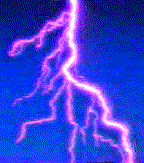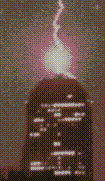 |
 Physics is good for understanding and dealing with the world around us...
It allows us to see the underlying connections among different phenomena,
and to make predictions about them. In many cases (volcanoes, floods, etc.)
accurate predictions may improve our lives or even save them. In the case
of lightning, annual costs in the US alone are approximately 200
dead, hundreds more injured, and over $2 billion in property damage.
Physics is good for understanding and dealing with the world around us...
It allows us to see the underlying connections among different phenomena,
and to make predictions about them. In many cases (volcanoes, floods, etc.)
accurate predictions may improve our lives or even save them. In the case
of lightning, annual costs in the US alone are approximately 200
dead, hundreds more injured, and over $2 billion in property damage.
More people in the US are killed by lightning than by floods, tornadoes or hurricanes.
In this course we will study many topics, but almost all of them have something
 to do with electricity. Lightning is the most dramatic example of electricity
at work in nature. Research on lightning goes back at least as far as the
work of Benjamin Franklin, who demonstrated the connection between electricity
and lightning with his famous (and dangerous) kite flying experiment.
to do with electricity. Lightning is the most dramatic example of electricity
at work in nature. Research on lightning goes back at least as far as the
work of Benjamin Franklin, who demonstrated the connection between electricity
and lightning with his famous (and dangerous) kite flying experiment.
Lightning occurs when an electrical current flows between the earth and storm
clouds. Although the details are still being researched, the basic ideas are clear. Small particles known as hydrometeors interact within the storm cloud. These particles transport charge within the cloud, usually carrying positive charge to the top of the cloud and negative charge to the bottom. This means that there will be large electric fields within the cloud, and between the cloud and the ground. The difference in electric potential (voltage) can be millions of volts.
Thanks to NASA for this image.

|
Eventually, the air is unable to insulate the cloud from the ground, and a large current results.
This brief description includes several important physical processes that we will discuss in the course. Some are in the current chapter, but some will come over the next few weeks. Try to look out for them as they come up!
- Charge transfer by collisions or friction (triboelectricity).
- Electric fields and potential differences around charges objects
- Polarization of insulating materials by an electric field.
- Dielectric breakdown
- Motion of charged particles in an electric current
Here are a few vital statistics about lightning.
- A typical bolt is 6 miles long.
- The temperature of the ionized air that we see over 25,000 °C.
- Typical cloud to ground voltage: few million volts.
- Peak power 1011 to 1012 Watts.
- Average duration: about 30 microseconds.
- Peak current: around 105 Amps.
- Total Energy: about 107 Joules.
Do not become a statistic. When lightning threatens, follow these
safety tips from the National Oceanic and Atmospheric Administration (NOAA), U. S. Department of Commerce.
- Stay indoors, and don't venture outside, unless absolutely necessary.
- Stay away from open doors and windows, fireplaces, radiators, stoves, metal pipes, sinks, and plug-in electrical appliances.
- Don't use plug-in electrical equipment like hair driers, electric toothbrushes, or electric razors during the storm.

- Don't use the telephone during the storm. Lightning may strike telephone lines outside.
- Don't take laundry off the clothesline.
- Don't work on fences, telephone or power lines, pipelines, or structural steel fabrication.
- Don't use metal objects like fishing rods and golf clubs. Golfers wearing cleated shoes are particularly good lightning rods.
- Don't handle flammable materials in open containers.
- Stop tractor work, especially when the tractor is pulling metal equipment, and dismount. Tractors and other implements in metallic contact with the ground are often struck by lightning.
- Get out of the water and off small boats.
- Stay in your automobile if you are traveling. Automobiles offer excellent lightning protection.
- Seek shelter in buildings. If no buildings are available, your best protection is a cave, ditch, canyon, or under head-high clumps of trees in open forest glades.
- When there is no shelter, avoid the highest object in the area. If only isolated trees are nearby, your best protection is to crouch in the open, keeping twice as far away from isolated trees as the trees are high.
- Avoid hilltops, open spaces, wire fences, metal clotheslines, exposed sheds, and any electrically conductive elevated objects.
- When you feel the electrical charge -- if your hair stands on end or your skin tingles -- lightning may be about to strike you. Drop to the ground immediately.
Nowadys, most lightning strikes in the US are recorded by the National Lightning Detection Network (NLDN), which consists of over one hundred antennae that report to a central data collection and processing computer. This system is run by Global Atmospherics, Inc.
Dont believe everything you read. I found a web site that included a fancy movie about how lightning works. It included the statement "lightning occurs when a cloud is charged with negative electrons and the ground is charged with positive electrons."
And because I can't resist, one last Spectacular Photo, also curtesy of NASA.
Lightning links
 The lightning page The lightning page
 The Exploratorium The Exploratorium
 Nasa Lightning Primer Nasa Lightning Primer
 Space Shuttle observations. Space Shuttle observations.
 Scientific American, August 1997 Scientific American, August 1997
 For extra credit, please answer the following questions (1 point each)
For extra credit, please answer the following questions (1 point each)
- Does lightning go up or down?
- What is a "stepped leader"?
- List at least three economically important forms of lightning damage.
- What is the triboelectric series?
- Explain what is wrong with the "don't believe everything you read" statement.
Please mail your responses to Dr. Gavrin.
|
 |





 Physics is good for understanding and dealing with the world around us...
It allows us to see the underlying connections among different phenomena,
and to make predictions about them. In many cases (volcanoes, floods, etc.)
accurate predictions may improve our lives or even save them. In the case
of lightning, annual costs in the US alone are approximately 200
dead, hundreds more injured, and over $2 billion in property damage.
Physics is good for understanding and dealing with the world around us...
It allows us to see the underlying connections among different phenomena,
and to make predictions about them. In many cases (volcanoes, floods, etc.)
accurate predictions may improve our lives or even save them. In the case
of lightning, annual costs in the US alone are approximately 200
dead, hundreds more injured, and over $2 billion in property damage.